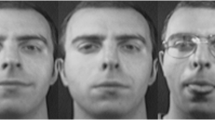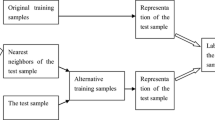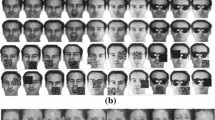Abstract
Sparse representation has attracted much attention in the field of biometrics, such as face recognition and palmprint recognition. Although the \(l_{p}\)-norm \((0 < p < 1)\) based sparse representation can obtain more sparse solution than the widely used \(l_{1}\)-norm based method, it needs to solve a non-convex optimization problem, which leads to poor robustness in real application. In this paper, we propose a robust \(l_{p}\)-norm sparse representation method with adaptive feature weighting. We derive the adaptive feature weighting method by self-paced learning (SPL), and utilize it to guide the features of \(l_{p}\)-norm sparse representation in the easy-to-hard learning process. Differing from existing SPL methods, feature weighted SPL in our method dynamically evaluates the learning difficulty of each feature rather than sample. For the advantages of the proposed method, it can avoid \(l_{p}\)-norm sparse minimization failing into bad local minima and reduce the effects of noise feature in the early learning stage. Experiments on several biometric image datasets show that our proposed method is superior to conventional \(l_{p}\)-norm based method and the state-of-the-art classification methods.









Similar content being viewed by others
References
Xu Y, Fan Z, Qiu M, Zhang D, Yang J-Y (2013) A sparse representation method of bimodal biometrics and palmprint recognition experiments. Neurocomputing 103:164–171
Deng W, Hu J, Guo J (2012) Extended SRC: undersampled face recognition via intraclass variant dictionary. IEEE Trans Pattern Anal Mach Intell 34(9):1864–1870
Wright J, Yang AY, Ganesh A, Sastry SS, Ma Y (2009) Robust face recognition via sparse representation. IEEE Trans Pattern Anal Mach Intell 31(2):210–227
Wang S-J, Yan W-J, Sun T, Zhao G, Fu X (2016) Sparse tensor canonical correlation analysis for micro-expression recognition. Neurocomputing 214:218–232
Cao F, Feng X, Zhao J (2017) Sparse representation for robust face recognition by dictionary decomposition. J Vis Commun Image Represent 46:260–268
Zhang Z, Xu Y, Shao L, Yang J (2018) Discriminative block-diagonal representation learning for image recognition. IEEE Trans Neural Netw Learn Syst 29(7):3111–3125
Gao S, Tsang IWH, Chia LT (2010) Kernel sparse representation for image classification and face recognition. LNCS 6314(4):1–14
Naseem I, Togneri R, Bennamoun M (2010) Linear regression for face recognition. IEEE Trans Pattern Anal Mach Intell 32(11):2106–2112
Yang M, Zhang L, Zhang D, Wang S (2012) Relaxed collaborative representation for pattern classification. Proc IEEE Comput Soc Conf Comput Vis Pattern Recognit 1:2224–2231
Liu G, Lin Z, Liu G (2010) Robust subspace segmentation by low rank represention. Icml 44(8):1432–1445
Jing Zong J, Shuang Qiu T (2017) Medical image fusion based on sparse representation of classified image patches. Biomed Signal Process Control 34:195–205
Yan K, Xu Y, Fang X, Zheng C, Liu B (2017) Protein fold recognition based on sparse representation based classification. Artif Intell Med 79:1–8
Zhang L, Yang M, Feng X (2011) Sparse representation or collaborative representation: which helps face recognition? In: 2011 International conference on computer vision, pp 471–478
Combettes PL, Pesquet JC (2011) Proximal splitting methods in signal processing BT—fixed-point algorithms for inverse problems. Fixed-Point Algorithms Inverse Probl 49(10):185–212
Ekanadham C, Tranchina D, Simoncelli EP (2011) Recovery of sparse translation-invariant signals with continuous basis pursuit. IEEE Trans Signal Process 59(10):4735–4744
Xu Y, Li Z, Yang J, Zhang D (2017) A survey of dictionary learning algorithms for face recognition. IEEE Access 5:8502–8514
Zhang Z, Xu Y, Yang J, Li X, Zhang D (2015) A survey of sparse representation: algorithms and applications. IEEE Access 3:490–530
Zheng L, Wang S, Liu Z, Tian Q (2013) Lp-norm IDF for large scale image search. In: 2013 IEEE conference on computer vision and pattern recognition, pp 1626–1633
Lu Y, Lai Z, Li X, Wong WK, Yuan C, Zhang D (2019) Low-rank 2-D neighborhood preserving projection for enhanced robust image representation. IEEE Trans Cybern 49(5):1859–1872
Bengio Y, Louradour J, Collobert R, Weston J (2019) Curriculum learning. In: Proceedings of the 26th Annual International Conference on Machine Learning - ICML’09, pp 1–8
Kumar MP, Packer B, Koller D (2010) Self-paced learning for latent variable models. Adv Neural Inf Process Syst 23:1189–1197
Zhao Q, Meng D, Jiang L, Xie Q, Xu Z, Hauptmann AG (2015) Self-paced learning for matrix factorization. AAAI pp. 3196–3202
Jiang L, Meng D, Yu SI, Lan Z, Shan S, Hauptmann A (2014) Self-paced learning with diversity. Adv Neural Inf Process Syst, pp. 2078–2086
Jiang L, Meng D, Zhao Q, Shan S, Hauptmann AG (2015) Self-paced curriculum learning. AAAI, pp 1–30
Lin L, Wang K, Meng D, Zuo W, Zhang L (2018) Active self-paced learning for cost-effective and progressive face identification. IEEE Trans Pattern Anal Mach Intell 40(1):7–19
Kumar MP, Turki H, Preston D, Koller D (2011) Learning specific-class segmentation from diverse data. In: Proceedings of the IEEE international conference on computer vision, pp. 1800–1807
Lee YJ, Grauman K (2011) Learning the easy things first: self-paced visual category discovery. In: Proceedings of the IEEE computer society conference on computer vision and pattern recognition, pp. 1721–1728
Amaldi E, Kann V (1998) On the approximability of minimizing nonzero variables or unsatisfied relations in linear systems. Theor Comput Sci 209(1–2):237–260
Zhang Z, Lai Z, Xu Y, Shao L, Wu J, Xie G-S (2017) Discriminative elastic-net regularized linear regression. IEEE Trans Image Process 26(3):1466–1481
Donoho DL (2006) For most large underdetermined systems of linear equations the minimal l1-norm solution is also the sparsest solution. Commun Pure Appl Math 59(6):797–829
Lu Y, Yuan C, Lai Z, Li X, Zhang D, Wong WK (2019) Horizontal and vertical nuclear norm-based 2DLDA for image representation. IEEE Trans Circuits Syst Video Technol 29(4):941–955
Floudas CA, Visweswaran V (1993) Primal-relaxed dual global optimization approach. J Optim Theory Appl 78(2):187–225
Lu Y, Lai Z, Xu Y, Li X, Zhang D, Yuan C (2016) Low-rank preserving projections. IEEE Trans Cybern 46(8):1900–1913
Jiang L, Meng D, Mitamura T, Hauptmann AG (2014) Easy samples first. In: Proceedings of the ACM international conference on multimedia—MM’14, pp. 547–556
Zhang M, Yang Y, Zhang H, Shen F, Zhang D (2016) L2, p-norm and sample constraint based feature selection and classification for AD diagnosis. Neurocomputing 195:104–111
Saab R, Chartrand R, Yilmaz O (2008) Stable sparse approximations via nonconvex optimization. In: 2008 IEEE international conference on acoustics, speech and signal processing, pp. 3885–3888
Chartrand R (2007) Exact reconstruction of sparse signals via nonconvex minimization. IEEE Signal Process Lett 14(10):707–710
Chartrand R, Yin W (2008) Iteratively reweighted algorithms for compressive sensing. In: 2008 IEEE international conference on acoustics, speech and signal processing, pp. 3869–3872
Chartrand R (2007) Nonconvex compressed sensing and error correction. ICASSP IEEE Int Conf Acoust Speech Signal Process Proc 3(3):889–892
Zhang Z, Shao L, Xu Y, Liu L, Yang J (2018) Marginal representation learning with graph structure self-adaptation. IEEE Trans Neural Netw Learn Syst 29(10):4645–4659
“PolyU multispectral palmprint Database.” [Online]. Available: http://www.comp.polyu.edu.hk/~biometrics/MultispectralPalmprint/MSP.htm
“PolyU FKP Database.” [Online]. Available: http://www.comp.polyu.edu.hk/~biometrics/FKP/polyudb.htm
Martinez AM, Benavente R (1998) The AR face database
Wright J, Yang AY, Ganesh A, Sastry SS, Ma Y (2009) Sparsity and robustness in face recognition. IEEE Trans Pattern Anal Mach Intell 31(2):210–227
Candès EJ et al (2011) Robust principal component analysis? J ACM 58(3):1–37
Liu G, Yan S (2011) Latent low-rank representation for subspace segmentation and feature extraction. In: 2011 international conference on computer vision, pp. 1615–1622
Xu Y, Zhang D, Yang J, Yang JY (2011) A two-phase test sample sparse representation method for use with face recognition. IEEE Trans Circuits Syst Video Technol 21(9):1255–1262
Acknowledgements
This work was supported in part by National Natural Science Foundation of China (Nos. 61732006, 61501230, 61876082 and 61861130366), National Science and Technology Major Project (No. 2018ZX10201002), and the Fundamental Research Funds for the Central Universities (No. NP2018104).
Author information
Authors and Affiliations
Corresponding author
Additional information
Publisher's Note
Springer Nature remains neutral with regard to jurisdictional claims in published maps and institutional affiliations.
Rights and permissions
About this article
Cite this article
Zhu, Q., Xu, N., Huang, SJ. et al. Adaptive feature weighting for robust Lp-norm sparse representation with application to biometric image classification. Int. J. Mach. Learn. & Cyber. 11, 463–474 (2020). https://doi.org/10.1007/s13042-019-00986-7
Received:
Accepted:
Published:
Issue Date:
DOI: https://doi.org/10.1007/s13042-019-00986-7




